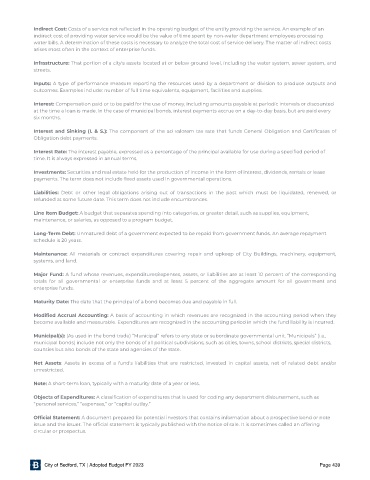Page 439 - Bedford-FY22-23 Budget
P. 439
Indirect Cost: Costs of a service not re ected in the operating budget of the entity providing the service. An example of an
indirect cost of providing water service would be the value of time spent by non-water department employees processing
water bills. A determination of these costs is necessary to analyze the total cost of service delivery. The matter of indirect costs
arises most often in the context of enterprise funds.
Infrastructure: That portion of a city's assets located at or below ground level, including the water system, sewer system, and
streets.
Inputs: A type of performance measure reporting the resources used by a department or division to produce outputs and
outcomes. Examples include: number of full time equivalents, equipment, facilities and supplies.
Interest: Compensation paid or to be paid for the use of money, including amounts payable at periodic intervals or discounted
at the time a loan is made. In the case of municipal bonds, interest payments accrue on a day-to-day basis, but are paid every
six months.
S .): The component of the ad valorem tax rate that funds General Obligation and Certi cates of
Interest and Sinking (I. &
Obligation debt payments.
Interest Rate: The interest payable, expressed as a percentage of the principal available for use during a speci ed period of
time. It is always expressed in annual terms.
Investments: Securities and real estate held for the production of income in the form of interest, dividends, rentals or lease
payments. The term does not include xed assets used in governmental operations.
Liabilities: Debt or other legal obligations arising out of transactions in the past which must be liquidated, renewed, or
refunded at some future date. This term does not include encumbrances.
Line Item Budget: A budget that separates spending into categories, or greater detail, such as supplies, equipment,
maintenance, or salaries, as opposed to a program budget.
Long-Term Debt: Unmatured debt of a government expected to be repaid from government funds. An average repayment
schedule is 20 years.
Maintenance: All materials or contract expenditures covering repair and upkeep of City Buildings, machinery, equipment,
systems, and land.
Fund: A fund whose revenues, expenditures/expenses, assets, or liabilities are at least 10 percent of the corresponding
Major
totals for all governmental or enterprise funds and at least 5 percent of the aggregate amount for all government and
enterprise funds.
Maturity Date: The date that the principal of a bond becomes due and payable in full.
Accounting: A basis of accounting in which revenues are recognized in the accounting period when they
Modi{ed Accrual
become available and measurable. Expenditures are recognized in the accounting period in which the fund liability is incurred.
Municipal(s): (As used in the bond trade) “Municipal” refers to any state or subordinate governmental unit. “Municipals” (i.e.,
municipal bonds) include not only the bonds of all political subdivisions, such as cities, towns, school districts, special districts,
counties but also bonds of the state and agencies of the state.
Assets: Assets in excess of a fund's liabilities that are restricted, invested in capital assets, net of related debt and/or
Net
unrestricted.
Note: A short-term loan, typically with a maturity date of a year or less.
Objects of Expenditures: A classi cation of expenditures that is used for coding any department disbursement, such as
“personal services,” “expenses,” or “capital outlay.”
Of{cial Statement: A document prepared for potential investors that contains information about a prospective bond or note
issue and the issuer. The of cial statement is typically published with the notice of sale. It is sometimes called an offering
circular or prospectus.
City of Bedford, TX | Adopted Budget FY 2023 Page 439

